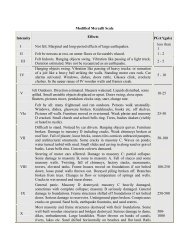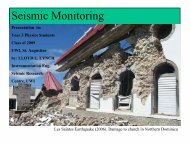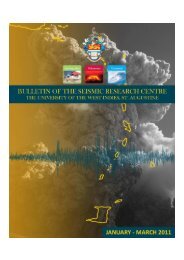Five Points of a New Architecture
Five Points of a New Architecture
Five Points of a New Architecture
You also want an ePaper? Increase the reach of your titles
YUMPU automatically turns print PDFs into web optimized ePapers that Google loves.
Global Earthquake Model!<br />
Caribbean Regional "<br />
!<br />
!<br />
Programme Workshop"<br />
Trinidad and Tobago, 2011 May 02-04!<br />
The <strong>Five</strong> <strong>Points</strong> <br />
<strong>of</strong> a <strong>New</strong> <strong>Architecture</strong> <br />
…in Earthquake Zones"<br />
Panelist – Robert V. Woodstock!
Configuration!<br />
The most important architectural<br />
d e c i s i o n s t h a t a f f e c t s e i s m i c<br />
performance are the critical decisions<br />
that create the buildingʼs configuration<br />
i.e. its size and shape.!<br />
!<br />
Simple symmetrical plans and forms are<br />
r e c o m m e n d e d o v e r c o m p l e x<br />
asymmetrical ones. !<br />
!<br />
“A square plan provides for a near<br />
perfectly balanced system”!<br />
- Christopher Arnold, “Seismic Issues in Architectural<br />
Design, Designing for Earthquakes, A Manual for<br />
Architects”!<br />
!
Influences on Seismic <br />
Performance!<br />
• Scale!<br />
• Horizontal size!<br />
• Proportion!<br />
• Symmetry!<br />
• Distribution and Concentration!<br />
• Structural Plan Density!<br />
• Corners!<br />
• Perimeter Resistance!<br />
• Redundancy!<br />
!<br />
-‐ Christopher Arnold and Robert Reitherman!<br />
“Building Configura3on & Seismic Design”!<br />
Redrawn from Building Configura3on & Seismic Design, Christopher Arnold and Robert Reitherman
Seismically desirable building attributes:!<br />
• Continuous load path!<br />
• Low height to base ratio!<br />
• Equal floor heights!<br />
• Symmetrical plan shape!<br />
• Identical resistance on both axes!<br />
• Identical vertical resistance!<br />
• Uniform section and elevation!<br />
• Seismic resistance elements at<br />
perimeter!<br />
• Short spans!<br />
• No cantilevers!<br />
• No openings in diaphragms (floors!<br />
and ro<strong>of</strong>)!
Historical Precedents:!<br />
The Parthenon!<br />
<br />
<br />
<br />
<br />
<br />
Golden Sec3on/Eleva3on redrawn from “<strong>Architecture</strong>:Form.Space & Order” – Francis Ching<br />
<br />
<br />
Photo credit: Google
Historical Precedents:!<br />
• The Pantheon!<br />
!<br />
Plan redrawn from “<strong>Architecture</strong>:Form.Space & Order” – Francis Ching<br />
Photo credit: David Mixer.com
The Domino System 1914-15!<br />
The Domino skeleton<br />
consisted <strong>of</strong> six thin<br />
concrete columns that<br />
simply carried two<br />
horizontal slabs as the<br />
floors and another as<br />
the ro<strong>of</strong>. The columns<br />
and slabs were<br />
connected by a<br />
staircase. Apart from<br />
this nothing else was<br />
fixed, thus permitting a<br />
great flexibility. !<br />
Redrawn from Le Corbusier: Oeuvre Complete, Willy Boesiger
LeCorbusierʼs <strong>Five</strong> <strong>Points</strong> <strong>of</strong> a <strong>New</strong> <strong>Architecture</strong>!<br />
• 1 - Raising the building on Pilotis!<br />
!<br />
• 2 - The Free Plan!<br />
• 3 - The Ro<strong>of</strong> Garden!<br />
• 4 - The Free Elevation!<br />
!<br />
• 5 - The Horizontal Window!<br />
!<br />
!
1. Raising the building on Pilotis<br />
“The rooms are thereby removed from the<br />
dampness <strong>of</strong> the soil; they have light and air; the<br />
building plot is left to the garden, which<br />
consequently passes under the house.”<br />
-‐ Le Corbusier Originally published in Almabach de l’Achitecture moderne, Paris 1926<br />
Redrawn from Le Corbusier: Oeuvre Complete, Willy Boesiger<br />
Photo credit: Valueyou, Wikiepedia
2. The Open or “Free” Plan!<br />
“The support system carries the intermediate<br />
ceilings and rises up to the ro<strong>of</strong>. The interior<br />
walls may be placed wherever required, each<br />
floor being entirely independent <strong>of</strong> the rest. ”!<br />
- Le Corbusier Originally published in Almabach de lʼAchitecture<br />
moderne, Paris 1926!<br />
Redrawn from Le Corbusier: Oeuvre Complete, Willy Boesiger<br />
Photo credit: Great Buildings
3. The Ro<strong>of</strong> Garden!<br />
The ro<strong>of</strong> gardens will display highly luxuriant vegetation.<br />
Shrubs and even small trees up to 3 or 4 metres tall can be<br />
planted. !<br />
!<br />
In this way the ro<strong>of</strong> garden will become the most favoured<br />
place in the building. In general, ro<strong>of</strong> gardens mean to a<br />
city the recovery <strong>of</strong> all the built- up area.”<br />
-‐ Le Corbusier Originally published in Almabach de l’Achitecture moderne, Paris 1926<br />
Redrawn from Le Corbusier: Oeuvre Complete, Willy Boesiger<br />
Photo credit: Great Buildings
4. The Free Elevation!<br />
“By projecting the floor beyond the supporting pillars,<br />
like a balcony all round the building, the whole facade is<br />
extended beyond the supporting construction. It thereby<br />
loses its supportive quality and the windows may be<br />
extended to any length at will, without any direct<br />
relationship to the interior division.<br />
-‐ Le Corbusier Originally published in Almabach de l’Achitecture moderne, Paris 1926<br />
!<br />
Redrawn from Le Corbusier: Oeuvre Complete, Willy Boesiger<br />
Photo credit: Great Buildings
5. The Horizontal Window!<br />
The whole history <strong>of</strong> architecture revolves<br />
exclusively around the wall apertures. Through<br />
the use <strong>of</strong> the horizontal window, reinforced<br />
concrete suddenly provides the possibility <strong>of</strong><br />
maximum illumination.”!<br />
- Le Corbusier Originally published in Almabach de lʼAchitecture !<br />
moderne, Paris 1926!<br />
Redrawn from Le Corbusier: Oeuvre Complete, Willy Boesiger<br />
Photo credit: Great Buildings
Villa Savoye <br />
Poissy, France!<br />
Photo credit: Valueyou, Wikiepedia
Villa Savoye <br />
Poissy, France!<br />
“It was Le Corbusierʼs Villa Savoye (1929–1931) that most succinctly summed up<br />
his five points <strong>of</strong> architecture that he had elucidated in the journal L'Esprit<br />
Nouveau and his book Vers un <strong>Architecture</strong> which he had been developing<br />
throughout the 1920s. First, Le Corbusier lifted the bulk <strong>of</strong> the structure <strong>of</strong>f the<br />
ground, supporting it by pilotis – reinforced concrete stilts. These pilotis, in<br />
providing the structural support for the house, allowed him to elucidate his next<br />
two points: a free façade, meaning non-supporting walls that could be designed as<br />
the architect wished, and an open floor plan, meaning that the floor space was free<br />
to be configured into rooms without concern for supporting walls. The second<br />
floor <strong>of</strong> the Villa Savoye includes long strips <strong>of</strong> ribbon windows that allow<br />
unencumbered views <strong>of</strong> the large surrounding yard, and which constitute the<br />
fourth point <strong>of</strong> his system. The fifth point was the ro<strong>of</strong> garden to compensate for<br />
the green area consumed by the building and replacing it on the ro<strong>of</strong>. A ramp rising<br />
from ground level to the third floor ro<strong>of</strong> terrace allows for an architectural<br />
promenade through the structure. The white tubular railing recalls the industrial<br />
"ocean-liner" aesthetic that Le Corbusier much admired. As if to put an<br />
exclamation mark after Le Corbusier's homage to modern industry, the driveway<br />
around the ground floor, with its semicircular path, measures the exact turning<br />
radius <strong>of</strong> a 1927 Citroen automobile.”!<br />
-‐ Villa Savoye and the <strong>Five</strong> <strong>Points</strong> <strong>of</strong> <strong>Architecture</strong> – Wikipedia<br />
!
Villa Savoye <br />
Poissy, France!<br />
Ground Floor! First Floor! Second Floor!
The Swiss Pavilion <br />
Paris, France<br />
!<br />
Ministry <strong>of</strong> Education!<br />
Kingston, Jamaica
ARCHITECTURE<br />
• “<strong>Architecture</strong> is a thing <strong>of</strong> art, a phenomenon <strong>of</strong> the emotions,<br />
lying outside questions <strong>of</strong> construction and beyond them. The<br />
purpose <strong>of</strong> construction is to make things hold together; <strong>of</strong><br />
architecture TO MOVE US.”<br />
• “<strong>Architecture</strong> is the masterly, correct and magnificent play <strong>of</strong><br />
masses brought together in light; Our eyes are made to see<br />
forms in light; Light and shade reveal these forms.”<br />
- Le Corbusier
Recommendations for Reducing the Problems!<br />
Use a design with the ideal configuration when:!<br />
• The best seismic performance for the lowest cost is needed!<br />
!<br />
• The maximum predictability <strong>of</strong> seismic performance is desired!<br />
!<br />
• The most economical structural design and construction is needed, including<br />
design and analysis for code conformance, simplicity <strong>of</strong> seismic detailing, and<br />
repetition <strong>of</strong> structural component sizes and placement conditions!<br />
!<br />
- Christopher Arnold, “Seismic Issues in Architectural Design, Designing for Earthquakes, A Manual for Architects”!<br />
!<br />
!
Recommendations for Reducing the Problems!<br />
With an irregular design configuration:!<br />
• A skilled seismic engineer, who is sympathetic to the architectʼs design<br />
intentions, should be used from the outset !<br />
• The architect should be prepared to accept structural forms or assemblies<br />
that may modify the design character, and should be prepared to exploit<br />
these as part <strong>of</strong> the aesthetic language <strong>of</strong> the design rather than resisting<br />
them!<br />
• The architect and engineer should both employ ingenuity and imagination <strong>of</strong><br />
their respective disciplines to reduce the effect <strong>of</strong> irregularities, or to achieve<br />
desired aesthetic qualities without compromising structural integrity!<br />
• Extreme irregularities may require extreme engineering solutions; these<br />
may be costly, but it is likely that a building with these conditions will be<br />
unusual and important enough to justify additional costs in materials,<br />
finishes, and systems.!<br />
• A s<strong>of</strong>t or weak story should never be used; this does not mean that high<br />
stories or varied story heights cannot be used, but rather that appropriate<br />
structural measures be taken to ensure balanced resistance.!<br />
!<br />
- Christopher Arnold, “Seismic Issues in Architectural Design, Designing for Earthquakes, A Manual for Architects”!<br />
!
The Engineer and the Architect<br />
• “The Engineer, inspired by the law <strong>of</strong> economy and<br />
governed by mathematical calculation, puts us in accord<br />
with universal law.<br />
• The Architect, by his arrangement <strong>of</strong> forms, realizes an<br />
order which is a pure creation <strong>of</strong> his spirit; by forms and<br />
shapes he affects our senses to an acute degree and<br />
provokes plastic emotions; by the relationships which he<br />
creates he wakes pr<strong>of</strong>ound echoes in us, he gives us the<br />
measure <strong>of</strong> an order which we feel to be in accordance<br />
with that <strong>of</strong> our world, he determines the various<br />
movements <strong>of</strong> our heart and <strong>of</strong> our understanding; it is<br />
then that we experience the sense <strong>of</strong> beauty.”a<br />
• N- Le Corbusier<br />
THE END














